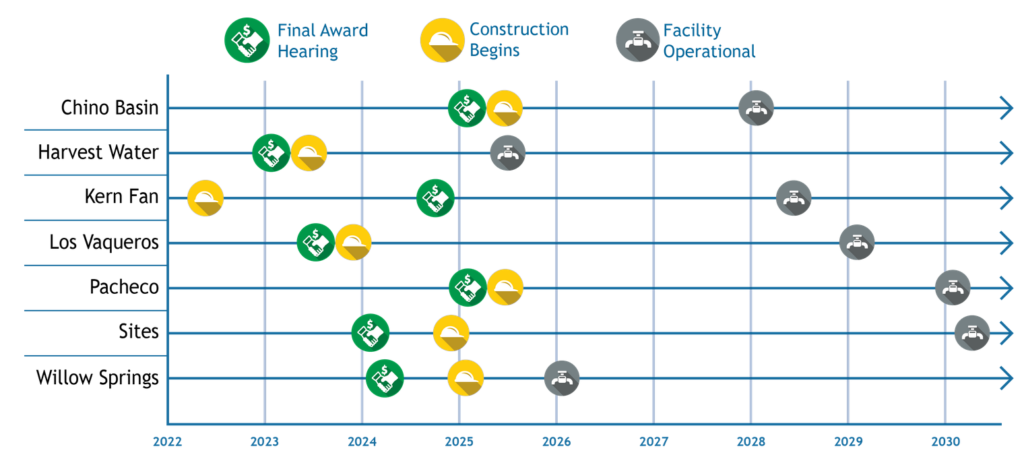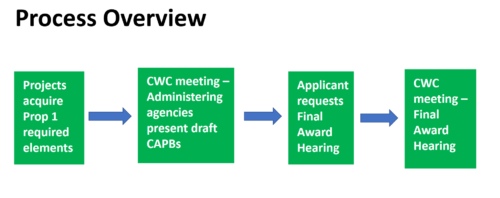At the September meeting of the California Water Commission, staff briefed commissioners on the Water Storage Investment Program and the contracts for public benefits.
Through the Water Storage Investment Program, the California Water Commission will invest nearly $2.6 billion in the public benefits of water storage projects. The legislation defines the public benefits as ecosystem, water quality, emergency response, flood, and recreation. Seven projects were selected and are progressing through the program: three surface storage projects and four groundwater projects.
 Before the projects receive funding from the program, they must complete the remaining requirements, one of which is finalizing contracts for the administration of public benefits. (Other remaining requirements include obtaining final permits, completing environmental documents, and securing commitments for non-WSIP funding.
Before the projects receive funding from the program, they must complete the remaining requirements, one of which is finalizing contracts for the administration of public benefits. (Other remaining requirements include obtaining final permits, completing environmental documents, and securing commitments for non-WSIP funding.
The contracts, formally called Contracts for Administration of Public Benefits, are a program requirement to ensure that the public benefits promised by the projects actually materialize. The regulations lay out several requirements for the contracts, including an adaptive management plan. Kristal Davis Fadtke with the Department of Fish and Wildlife noted the inclusion of an adaptive management plan is important because these are long-term contracts, and these projects will need to adapt in the face of changing circumstances.
Ecosystem benefits of the projects under the purview of the Department of Fish and Wildlife include flow and water quality improvements; pulse flows and increased base flows to benefit salmon; water for wildlife refuges; and water for wetland, riparian, and vernal pool habitats. Two projects will contract with the State Water Board to provide water quality public benefits by reducing salinity in impaired surface waters and improving groundwater quality. The Department of Water Resources will administer the public benefits of six projects, which include flood control, recreation, and emergency response.
When the water storage projects were chosen, the Commission determined the funding award for each project based on the projected amount of public benefits it would provide. However, as the projects progress through environmental review and various permitting processes, those benefits will likely change. The WSIP regulations anticipated that, so the administering agencies must confirm that the public benefits will meet the program’s requirements and that the project will yield net measurable improvements to the ecosystem before the final funding is awarded.
“When we do get to a point where we have final contracts for public benefits, it will be more clear at that time what the actual public benefits are that have been contracted for,”said Amy Young, Program Manager. “The Commission’s role in that at that point is to look at what is actually contracted for. And we will have additional analysis from staff and recommendations … our hope is that the benefits remain fairly consistent and the Commission can make an easy decision. … But the Commission does have the discretion to make a award based on what they see in these final contracts.“
Additionally, before the contract can be finalized, all agreements with third parties must be in place, such as landowner agreements, conservation easements, water rights, conveyance priorities, and any other agreements necessary to deliver the public benefits being contracted for.
 Before finalization, drafts of the contracts will be presented to the Commission and available for public review and comment; however, the Commission will not vote on them. The final contracts will become part of the WSIP funding agreement and must be executed before the final award hearing. Since the WSIP projects are all on different schedules, the draft contracts are expected to trickle in over the next several years.
Before finalization, drafts of the contracts will be presented to the Commission and available for public review and comment; however, the Commission will not vote on them. The final contracts will become part of the WSIP funding agreement and must be executed before the final award hearing. Since the WSIP projects are all on different schedules, the draft contracts are expected to trickle in over the next several years.
Ms. Fadtke importantly noted that there is no funding for the role of the state in managing these benefits or for long-term monitoring. “The regulations note that the data management plan needs to identify funding for monitoring. But it’s not specific about who funds the monitoring. And that can be a really substantial cost for some of these projects. Part of what we’re going to be doing is identifying existing monitoring programs out there that the projects can utilize. But there may be cases where we need to fill that hole. … So I want to bring forward here today that we need to keep having this conversation about how we support these projects long term and the monitoring needs for public benefits.”
The Commission also discussed remedies if, down the road, the public benefits do not materialize. Staff noted that these contracts are novel and something not done before; folks are still working through some of the parameters.
Commissioner Sandi Matsumoto said she’s concerned about shifting baseline. “This comes up over and over again with ecosystem targets is that we articulate a set of ecosystem benefits that we’re trying to achieve, especially when it comes to flows, and over time, sometimes for good reason, we lower the target, because there’s a lot of other pressures on the water system. So I think it’s important for us as we’re talking about the remedies, that we’re establishing a record of what the intention of the Commission is when we approve these contracts. We need to be very clear about what our expectations are and that those are not negotiable, because they are what the public is paying for. And that’s the agreement we’re making right now. And I want to put that in the record, because it sounds like there’s a lot of discretion that’s involved in this as we go forward.”
With no clear answers at this time, Commissioners requested that the final contract hearing should include a discussion of possible remedies if the promised public benefits do not materialize.
Commission opts for virtual site visits
In July 2022, the Commission discussed the possibility of visits to the Water Storage Investment Program project sites. At the time, the commissioners’ concerns included the costs involved and the potential to impact project timelines. The Commissioners asked the staff to return with more information.
At the September California Water Commission meeting, commissioners resumed the discussion. Staff recommended virtual site visits due to the complex noticing requirements and ex-parte constraints. After some discussion, the Commission voted unanimously for the virtual site visits.



